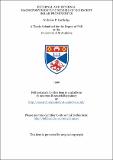Files in this item
External and internal magnetohydrostatic models of quiescent solar prominences
Item metadata
| dc.contributor.advisor | Priest, E. R. (Eric Ronald) | |
| dc.contributor.advisor | Hood, Alan W. | |
| dc.contributor.author | Cartledge, Nicholas P. | |
| dc.coverage.spatial | 169 p. | en_US |
| dc.date.accessioned | 2018-06-13T15:52:27Z | |
| dc.date.available | 2018-06-13T15:52:27Z | |
| dc.date.issued | 1996 | |
| dc.identifier.uri | https://hdl.handle.net/10023/14029 | |
| dc.description.abstract | Quiescent solar prominences are amongst the most interesting and yet least understood of the phenomena observed on the Sun and provide both the theorist and the observer with equally demanding challenges. The theoretical study of prominences is an important branch of solar physics as it contributes significantly to the overall understanding of the Sun and its atmosphere. One only needs to be presented with the illuminating fact that there is more mass contained in these bodies than in the remainder of the entire corona to be convinced of their importance. Although many of the physical mechanisms associated with prominence theory are important in their own right, they are also of much wider relevance for various other astrophysical phenomena. For example, radiative and magnetic instabilities are explored in detail in the context of solar prominences; yet clearly these are important processes that relate to many other branches of astrophysics. Prominences are intimately associated with solar flares which occur when a prominence loses equilibrium. Also, prominence eruptions are very important as they are closely connected with coronal mass ejections. These account for a large fraction of the total mass lost from the Sun and so are extremely important events, particularly when one considers the consequences as this plasma interacts with the Earth's environment. It is the period of global equilibrium of quiescent prominences, though, that is the focus of this thesis. Various models are proposed to help understand both the topology and supporting mechanisms of the external, coronal magnetic field, and also the internal prominence structure and the way in which the two regimes fit together. In Chapter 3 we extend a model for the equilibrium of a prominence sheet in a twisted magnetic flux-tube, given by Ridgway, Priest and Amari (1991), to incorporate a current sheet of finite height. This removes the discontinuity at the edge of the tube and provides a shear-free outer boundary which enables the tube to be matched onto a background potential field. In addition, internal prominence solutions are found by expanding the sheet to a finite width and matching suitable magnetic profiles across this region. Next we consider a global model for the magnetic field structure surrounding a polar-crown prominence. We examine potential configurations generated from typical distributions of photospheric flux, and select solutions for which there is a location of dipped magnetic field where prominence material may collect and form. Once such a configuration is available, it is necessary to construct the ensuing prominence solution. We achieve this in Chapter 4 by considering a simplified form for the photospheric field. We show that the equilibrium contains a weighted, curved prominence sheet supported in the location of dipped magnetic field. The equilibrium requires an enhanced magnetic pressure below the sheet to support the component of weight in the normal direction. The internal equilibrium of curved or inclined prominence material has not been considered previously and so we formulate, in Chapter 6, a simple one-dimensional isothermal solution for a cut across the prominence. This is developed to allow for variations along the sheet and in this way an internal solution for the curved prominence of Chapter 4 is given, which matches onto the external potential polar-crown field. Finally, in Chapter 7, we rewrite this solution in terms of its constituent internal and external components and show how the composite solution switches between the two in a region of overlap, or transition region. From this, the internal plasma properties are deduced and realistic profiles for the pressure, density and temperature are obtained. | en_US |
| dc.language.iso | en | en_US |
| dc.publisher | University of St Andrews | en |
| dc.subject.lcc | QA927.C3 | |
| dc.subject.lcsh | Wave-motion, Theory of | en |
| dc.title | External and internal magnetohydrostatic models of quiescent solar prominences | en_US |
| dc.type | Thesis | en_US |
| dc.type.qualificationlevel | Doctoral | en_US |
| dc.type.qualificationname | PhD Doctor of Philosophy | en_US |
| dc.publisher.institution | The University of St Andrews | en_US |
This item appears in the following Collection(s)
Items in the St Andrews Research Repository are protected by copyright, with all rights reserved, unless otherwise indicated.

